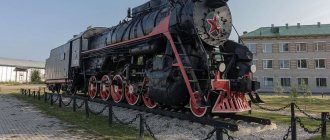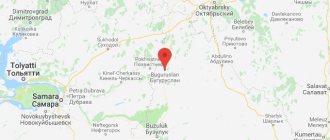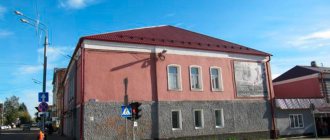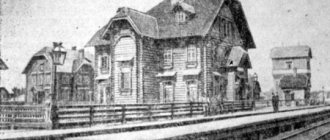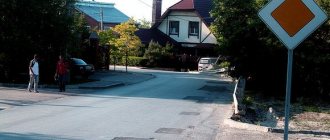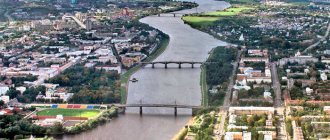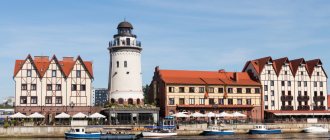Kimry as a toponymic riddle
I remember back in the 70s they gave me luxury sneakers with the name “Kimry” on the soles.
The sneakers were comfortable and lasted a long time. But I still remember how surprised I was by the wonderful name - Kimry. And, apparently, I was not the only one surprised by this name. Even the great Tatishchev in the 18th century drew attention to the name of the shoemaking capital of the Russian Empire:
Is this name Estonian, Mordovian, it means bearish - as in Estonia there was the city of Kirempe, in Russian - “Bear’s Head”. Kirema is a river flowing into the Volga, in Russian - Medveditsa. Maybe the Kimrys themselves were called Kirems.
The Wiki says the following about the name:
There are several versions of the origin of the city's name. Among local historians, the possibility of the origin of the word “Kimra” (“Kimera”, “Kimerya”, “Kimer”) from the name of one of the Finno-Ugric tribes - Merya is being considered. The Meryans lived in the Upper Volga region and the Klyazma River basin on the territory of modern Yaroslavl, Ivanovo, in the northern and central parts of the Vladimir, northern and eastern parts of the Moscow, eastern part of the Tver, southern part of the Vologda and western part of the Kostroma regions of Russia.
History of the city of Kimry
The first time, then still the village of Kimry, was mentioned in the charter of Ivan the Terrible dated 1546. You can get acquainted in more detail with the contents of the first official mention of Kimry in one of the articles “Essays”. By that time it was already a fairly large trading village in the Korchevsky district of the Tver province, its inhabitants were famous as skilled artisans.
Back in 1677, the palace village was under the jurisdiction of the Grand Palace, then it belonged to the Saltykovs and Skavronskys. In 1847, the residents of this village were bought from Countess Yu.P. Samoilova to freedom with the land. On our website you can find out more detailed information about the owners of the village of Kimry.
Even Empress Catherine II favored Kimry with her attention. In her diary from 1767 you can find the following entry: “Hour by hour the banks of the Volga are getting better. Yesterday we passed Kimru, which from a distance is not inferior to Peterhof, but up close it’s not the same.” We propose to learn in more detail about the empress’s participation in the development of the village and the province as a whole in the article “Kimry - the village.”
In the 18th century, the village became the center of the shoemaking industry. Kimry craftsmen receive government orders to sew shoes for the army. By the beginning of the 20th century, the village already exceeded many county towns in terms of the number of inhabitants (10 thousand), and wealthy Kimryaks even built houses in the “modern” style. Those who are interested can read the architectural characteristics of the city on our website.
The change in the status of Kimry had been brewing for a long time, but Kimry received the right to be called a city only in June 1917. Later, the ancient village of Savelovo, where the railway station of the same name is located, belongs to the Oktyabrskaya Railway, connecting the cities of Moscow and St. Petersburg, also became part of the city. In 1926, a machine-building plant and a workers' village were built in Savelovo.
The Moscow-Savelovo railway line was put into operation in 1900. Traffic to Kalyazin was opened only in 1919. Since 1920, regular communication with Rybinsk and Vesyegonsk began, and in the mid-30s, traffic was opened to Uglich. Finally, the construction of the Ovinishche - Mga line, completed in the 50s, made the Savelovskaya branch a reserve backup for the Moscow-Leningrad railway. In 1978, the Verbilki-Savelovo section was electrified, which made communication with Moscow by electric trains possible.
For a long time, the Savelovo station was used for transshipment of cargo onto flat-boats, where they were transported along the Volga to Rybinsk and then transferred to barges. Since 1940, after the implementation of the “Big Volga” master plan as a result of the construction of the Ivankovsky, Uglich and Rybinsk hydroelectric complexes, the Volga became navigable to Tver and the need for transporting large cargo along the Savelovskaya branch disappeared.
“I measured it, I made a miracle...”
If you are interested in the toponymy of Russia, then you probably noticed that most toponyms and hydronyms are attributed to the chronicled Merya tribe. I suspect that this is being done in order to write off attempts to decipher the names of cities and other villages using the Russian language. As a rule, these attempts lead to unmotivated translations. And with the measure - what beauty! It is believed that this people disappeared in the Slavic colonization flow. And if so, Meryan words can be designated untranslatable with a calm research soul. But there is a nuance: many researchers of the 18th and early 19th centuries wrote that the Merya did not disappear anywhere, but lives where it lived for hundreds of years. The Merya calls itself Mori, and the Russians call this Mori Mordovians.
December 10, 2021
Reconstruction of Savelovo station. Final chapter. November 2021
The time has come for the last chapter about the reconstruction of Savelovo station. From 2021 to this year, I watched how the station changed, how the work progressed. During this time I wrote a lot of posts, there was a lot of negativity and positivity, but where would we be without it?
And so, in November 2021, the first stage of reconstruction of the Savelovo station was completed as part of the project for the development of the Dmitrov - Sonkovo - Mga line to increase capacity. Over these two years, the station has changed beyond recognition. To be honest, I lost all desire to film around the station, primarily because of the reactions of local residents who do not understand simple things, and on the other hand, the station became simply boring. But I thought that I needed to sum it up and shoot the last chapter.
On November 27, I took the morning electric train to Savelovo to assess the scale of the disaster.
The electric train to Savelovo is traditionally full, and as soon as you leave one stop from Degunino, the traffic of traders begins. Many noted that there are none within the boundaries of the MCD, but you will get on an electric train to Savelovo in the morning and you will be a little surprised. In the first 10 minutes, the entire assortment from Aliexpress went through, and then after that they carried all kinds of snacks - cauliflower, tomatoes and cucumbers. So it turns out that the electric trains are new, but the atmosphere is the same.
According to Catuar, I noticed a revival in the reconstruction of the platform - apparently they remembered what needed to be completed. And between Katuar and Trudovaya a merchant grandfather came in, I barely recognized him. He used to always sell vegetable peelers and was slightly positive, but now he has aged very much. He could barely stand with his cane, let his gray beard grow, but still fervently tried to talk about what he was selling. And then I caught myself thinking that time spares no one and how much I travel in this direction - I already know many of the sellers by sight. To be honest, I even felt a little uncomfortable with how quickly time was passing.
The Iksha turned out to be empty, then the green VL11 flew as a reserve along Trudovaya. I thought it was strange. Intelligence reported a powerful movement. But in Dmitrov everything fell into place: in the departure park we were stuck waiting for the green signals VL11 and VL10U with freight trains, but we were not sent because we were waiting for an oncoming train from Savelovo. In total, according to Dmitrov, there are three freight trucks at once. A separate report should have been made about the Dmitrov station a long time ago, because the Taldom neck of the station has already changed quite a lot. Beyond Dmitrov everything was as before, along Verbilki there was a traditional crossing with an electric train from Dubna, but we were already running late, as if a freight train was crawling ahead of us. At Taldom, this theory was confirmed; there, we were allowed ahead by the Oryol tee with a bulk train, already familiar to me from the last foray into Iksha.
Savelovo greets with gray and cool weather, an abundance of green electric locomotives that were ready to go with freight trains to Orekhovo and Bekasovo. Here I will add an abundance of noise barriers and ice. There was ice everywhere where people walked and the station workers simply hammered home the bolt. And we will begin examining the station, or rather what was done to it. Let's start point by point.
Since 2021, the following has been done at Savelovo station:
1. We increased the length of the receiving and departure tracks to 71 conditional cars, and completely laid a new track.
2. New lighting was installed - now the station looks like a Christmas tree at night. This is what most stations look like on the main OCT route between Moscow and St. Petersburg.
3. We built a normal turnaround point for electric trains from Moscow. Now there are 3 tracks and electric trains do not interfere with the high platform.
4. Manual arrows are a thing of history. Now the entire station is automated. To this we add a new electrical centralization post, which was opened quite recently. Now the duty officers are sitting there, and in the station building only the TsPPK ticket office and the local transport police department remain.
5. Conducted a major overhaul of the track from 129 km to 139 km.
In fact, the first stage of reconstruction is over, only a little remains. This is to complete several exhaust dead ends, organize the operation of the signaling system and switches, and complete the construction of a rest house for locomotive crews.
I decided to inspect the station in the Kalyazin neck of the station, although getting to it was a quest due to the abundance of ice on the platform and paths. There is a large crowd of local workers here, because sprinkling sand in the morning takes literally half an hour. As a result, while I was walking with breaks, I watched as older people, and even young people, dashingly fell on their fifth points, and some rolled towards the tracks. Sorry, this is a security breach. What if the train leaves? But the workers didn't care. I remember they reproached me that I always defend Russian Railways, but not always. This is a direct violation of the safety of passengers. At the local PTOL, a diesel locomotive of the 2TE116 series from the Ivanovo Northern Railway depot stood muttering in a hot state. Yes, I think many people can break the mold this way, but the Ivanovo depot has its own 2TE116, but it was unexpected to find such a machine in our area, but we’ll return to it later. The first thing that will catch the eye of any tourist, photographer or ordinary person is the new green fence around the perimeter of the station. Well, if it were an ordinary fence, it would also have barbed wire. You got the feeling that you were somewhere on the border, like Pytalovo or Ivangorod somewhere.
Here, a technical passage was made nearby for locals who need to cross the railway tracks to the other side, but it is impossible to walk along such a road, because it is all covered in ice. Questions again for the station workers. After all, carriages also walk on ice.
Now let's look at the station.
The entire station has shunting signals on, which is very unusual. For the adherents who call our road wooden, I send a big hello. In the Kalyazinskaya neck of the station, minor work was still going on - the noise barrier had not been fully installed, local workers were doing something at the switches.
What shines in between is not water, but ice. I heard a lot of flattering reviews from local residents about this. But as soon as I appeared with a camera, the local workers became a little embarrassed, and their leader quickly walked away towards the station. I thought that either my favorite police officer would come and present me for filming, or something else, but everything went quietly. And we take a look at Moscow, where a freight train has just arrived from Taldom.
The station was quite crowded with trains - 4/6 of the tracks were occupied. While standing and observing the life of the station, a diesel locomotive appeared from under a commuter train. He was performing maneuvers for a flight to Uglich. The locomotive number is already original.
I also photographed this diesel locomotive in blue, and then in green. Now he was caught in the third color option. Thanks to the included EC at the station, train turnover can occur faster. For example, instead of taking an hour and a half, freight trains now make a turnaround in 55 minutes, and maneuvers are even faster. But the schedules of passenger trains and commuter trains, alas, have not yet been touched.
So the M21 signal turned white. Photo for those who do not believe or will not believe that electrical centralization works in Savelovo.
A minute later, the diesel locomotive passed the M21 and proceeded under the commuter train to Uglich. And I took a walk towards Burkovo, where I found a cry from the locals.
Of course, they can also be understood. Any construction site causes discomfort, but most of the problems are still the responsibility of the local administration. For example, the same roads in villages should have been built by the authorities, not Russian Railways. The expansion of the Savelovsky direction has been known since 2014, and in just 7 years it is possible to build new roads. Same story with the move. In fact, Russian Railways, with its construction, opened an abscess that had been swelling for a long time in the city of Kimry, but local residents do not want to figure it out and blame others for everything, but not themselves, not the local administration. Construction will end, the builders will clean up after themselves wherever they can, and the roads in the villages will remain as they were 7-9 years ago. Well, as for the noise of trains, dangerous cargo, etc., I can only answer this way - you can write a letter to Russian Railways so that electric trains to Moscow are canceled and everyone will feel calmer, because electric trains also create noise.
Let's get back to the positive. Here at the station I finally met Sasha Konov, one of the members of our “Savelovskaya Magistral” community, we thought a little and decided to go towards Bely Gorodok, because there was nothing else to catch at the station. On the way, while we were walking to the station, I photographed a commuter train to Uglich.
I often come across expressions on all sorts of forums and chats, like people don’t come here and nothing new is needed here. But these people, living in Moscow, forget one thing. To bring back passengers, we need development and convenient train schedules. Now they are not particularly successful and the entire system of commuter trains from Savelovo to Pestovo needs to be updated and shaken up. Personal observation. On the Sonkovo-Savelovo train, 30 people arrived in two seated carriages. Saturday is not the peak day. About 25-30 people boarded the same two carriages at Uglich. I do not rule out that almost everyone goes to Kalyazin. During the season and peak days, these numbers can be safely multiplied by two, or even more. In the summer these are fishermen and summer residents. On Sundays and Fridays - students who live in Kashin and Kalyazin. More convenient communication has been needed here for a long time and preferably with acceleration, but for now, alas. Cities such as Kashin, Kalyazin and Uglich have great potential to become tourist destinations, which is now in fashion.
And we went to White Town, which will be a separate story. I also haven’t been to those parts for a very long time and it’s time to catch up. But we will return to Savelovo. Here, during our absence, there was a blockage at the station - there were no free tracks for receiving freight trains and there were no free diesel locomotive crews. Now this picture is more than real on our line. Due to the fact that there are more freight trains, there are traffic jams and delays at the station. On the day I was in Savelovo, about 10 pairs of freight trucks passed through the junction. In fact, this is the main problem of delays of electric trains from Savelovo and Dubna in the last month - the low capacity of the Moscow Railway from Savelovo to Dmitrov. I have written many times who is to blame for this and why, I will not describe it again. I’ll just say that this will happen for at least another 1.5 years, until 3 sidings are built on the Moscow Railway.
The main goal for which we returned to the station was the northern 2TE116, which was supposed to be driven under the train. In general, locomotives from the Northern Railway are no longer uncommon in Savelovo - 2TE116UD are the main locomotives on our route to Sonkovo, along with 2TE25KM. I still remember the moments when 2TE10V, 2TE10M/U from Ivanovo, Pechory came running here. But it was a long time ago. 2TE116 appeared in Ivanovo relatively recently and most machines work with PMS. Only 3-4 diesel locomotives out of 10 were seen in train work. This one wandered into our Savelovo, and since the bird is rare, it must be in the archives. We arrived on time, the diesel locomotive was just changing its cabin and maneuvering under the train.
I said that I filmed everything in Savelovo. As it turned out, there is more to come and sometimes there are interesting objects. On the second route, another 2TE116 was bored, waiting for the brigade. Quite suddenly, that day we saw as many as two old cars - now this is a rarity.
On this note, I said goodbye to Sasha and ran to the electric train to Moscow. It would be illogical to wait for the cargo to depart, since daylight hours are now short. By the way, as soon as they noticed me with the camera in the morning, by lunchtime the station was sprinkled with sand everywhere, which turned out funny.
For the first time at the Savelovo station I saw three diesel locomotives and only one electric locomotive. Usually, there has always been a shortage of OCT machines, but now it’s the other way around.
On the way, I came across 3 more freight trucks to Savelovo along Taldom, Verbilki and Dmitrov. Later it is learned that trains were also accumulated in Bely Gorodok, Sknyatino, and Kashin. I sense such movement - there was a small rehearsal of the new schedule.
Today, exhaust dead ends in Savelovo are being completed and, in general, traffic has calmed down a little. Previously, they wanted to increase the volume of traffic to a stable 8-10 pairs, which is almost equal to the traffic in Volokolamsk - there are stable 10-13 pairs.
Whether there will be a second stage of construction in Savelovo is unknown, as is the second stage of the entire project. Now almost all sidings have been completed (except for Dunevka and 50 km), and many have undergone major repairs of tracks and bridges.
The Savelovskaya Highway is now not the same road that was a protected wooden one. Now it is a small organism transporting freight in the direction of St. Petersburg. Thanks to this, Savelovo suddenly comes to life, the Khvoinaya station is being rebuilt and a new depot is being built there, which will most likely have its own assigned park. I will hope in my heart that this construction will give at least a small impetus to the development of passenger transportation, I know that there are not many people, but sections can and should be developed.
As for the Savelovo station, this was the last chapter with the construction of the station. I don’t see any point in writing or talking about anything anymore - almost everything is done. As part of our community and this blog, from time to time I will photograph the life of the station and its surroundings. I know that my blog is often googled for construction and other queries, I hope this post will be useful.
Source:
Savelovskaya Magistral
City of Kimry. origin of name
Merya is Mordvinian. Well, or people close in culture and language to Moksha and Erza. If so, then the “untranslatable” Meryan toponyms and hydronyms should be somehow motivated to be translated using, for example, the Erzya language.
Let me emphasize : motivated means reflecting a certain physical reality associated with the specifics of a particular area or craft.
In the case of Kimry, we are dealing specifically with the craft activity of the city residents - the production of boots. But then it turns out that neither the Cimmerians nor the other Krivichi have anything to do with the word “Kimry”. More precisely - Kimra.
Pay attention to the end of the word - Ra. In Mordovian languages, Ra is the name of the Volga River. Sometimes they say Rav or Rava, that is, Mother Volga.
What is “Kim”? Let us assume that Kim is the word Kem, modified during oral transmission, that is, “boot.”
It turns out that Kimry - Kimra - Kemra are “Volga boots” or “boots from the Volga”.
A clearly motivated and logical translation of the name of the Russian shoemaking capital. Kimra - Volga boots. I think it's cool! And what do you think?
Kimry today
The city of Kimry is located on both banks of the Volga River. It owes both its origin and its further development to it. Currently, there are transit and intra-city berths in Kimry. On the left bank, the city center is now located. Many ancient buildings have been preserved here, most of which are architectural monuments. The Savelovo microdistrict, located on the right bank of the Volga, is predominantly built up with more modern houses.
The banks are connected by a large bridge across the Volga, built in the early 80s and restored in the 21st century. Until this time, the crossing was carried out using passenger and cargo ferries. There are roads leaving the city in three directions. The ancient Ilyinskaya road through Goritsy leads to Tver and Kashin. You can get to the capital along the Moscow road through Dubna and Dmitrov. The Taldom road leads to Bely Gorodok, Taldom, and Kalyazin. You can also get to Dubna and further along the local road leaving from Savelovo station.
The city of Kimry is surrounded by both large and small settlements. There is a regular bus service between the city and most of them. Kimry is connected by bus routes to the cities of Tver and Moscow, the distance to which is 135 and 150 km, respectively. In addition to buses, Kimry is also connected to Moscow by the Savelovo railway station. You can find out the schedule of buses and electric trains in the main section of the site.
Long-distance communication is provided with Moscow and Rybinsk. Suburban communication by electric trains is carried out with Taldom, Dmitrov, and Moscow. Suburban service has been organized with Kalyazin, Uglich, Kashin, and Sonkovo by “working” trains with diesel traction.
Kimry is a port city on the Volga, and 15 km downstream in Bely Gorodok there is a large ship repair enterprise.
The area of the city of Kimry is approximately 43.6 square kilometers, of which 4.4 square kilometers are occupied by household plots of citizens, and 3.4 by collective gardens.
Today, according to the 2010 All-Russian Population Census, 49 thousand people live in the city.
Kimry is the largest industrial center in the region. The city's industry is represented by various sectors. The main ones are mechanical engineering (machine tool building, aircraft factories of the military-industrial complex), light industry (clothing, shoe industry and furniture production) and food industry. The region's economy employs more than 26 thousand people.
Meat and dairy cattle breeding and pig breeding are developed in the Kimry region. Potatoes are grown.
The city has a mechanical and technological college, a medical school, and a branch of the university.
Kimry on the map of Russia: geography, nature and climate
Kimry is located east of the regional center, 100 km from the capital of Russia. The settlement was built where the Kimrka River flows into the Volga . The relief features within the city are due to its location in the Upper Volga lowland . The height of the area above sea level is 100-130 meters. Swampy, podzolic and floodplain soils predominate.
Kimry is a typical city with a temperate continental climate. Summers in these parts are cool and humid, winters are quite long and cool. In July, the warmest month of the year, the average air temperature is around +18.7 °C; in February the air cools down to −7.6 °C.
Looking at the map of Kimry from a satellite, one cannot help but notice that the city is surrounded by forests. Both coniferous and deciduous trees grow here. Hares, foxes and raccoon dogs are found in the forests. Beavers live in rivers.

